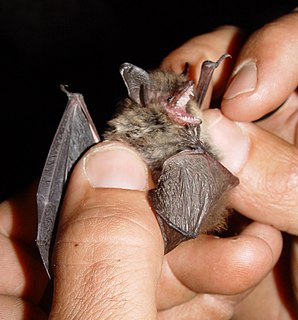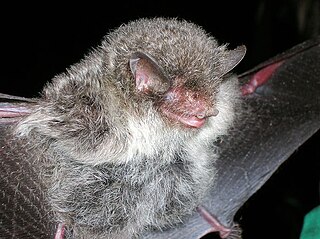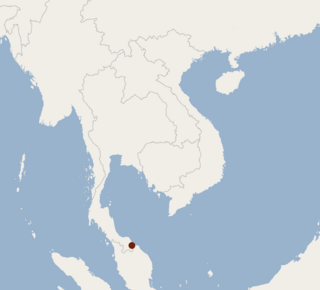
The mouse-eared bats or myotises are a diverse and widespread genus (Myotis) of bats within the family Vespertilionidae. The noun "myotis" itself is a New Latin construction, from the Greek "muós and "oûs", literally translating to "mouse-eared".

Murina is a genus of vesper bats. They are found throughout temperate and tropical regions of Asia.

The bronze tube-nosed bat is a species of vesper bat in the family Vespertilionidae. It is found only in Malaysia.
Hutton's tube-nosed bat is a species of vesper bat in the family Vespertilionidae. It can be found in the following countries: Bhutan, China, India, Laos, Malaysia, Myanmar, Nepal, Pakistan, Thailand, and Viet Nam. It lives within an elevation of 1450 m to 2500 m. In Southeast Asia, the bat is considered to be uncommon. The bat is known to live in forests, roosting among the leaves of banana trees. Its habitat is threatened by deforestation for firewood and timber, as well as conversion to agricultural land.
The gloomy tube-nosed bat is a species of vesper bat in the family Vespertilionidae. It is only known by the holotype, an old female, collected on Tsushima Island in 1962. It might be possibly extinct as Tsushima is badly deforested and surveys to rediscover this species failed. Due to its imperiled status, it is identified by the Alliance for Zero Extinction as a species in danger of imminent extinction.
Scully's tube-Nosed bat is a species of vesper bat in the family Vespertilionidae. It can be found in the following countries: India, Laos, Myanmar, Pakistan, Thailand, and Viet Nam.

Cadorna's pipistrelle is a species of vesper bat in the family Vespertilionidae. It is found in India, Laos, Myanmar, Thailand, and Vietnam.

Taddei's serotine is a species of medium-sized bat belonging to the family Vespertilionidae. It is restricted to the Atlantic Forest of southern Brazil.

Harrison's tube-nosed bat is a species of vesper bats (Vespertilionidae). Within the genus Murina, it belongs to the so-called 'cyclotis-group'.

Hilgendorf's tube-nosed bat is a species of vesper bat in the family Vespertilionidae. In Japan they are called 'tengu komori', after the mythical creature called the Tengu. It was formerly thought to be a subspecies of Murina leucogaster, but is now known to be a distinct species.

Beelzebub's tube-nosed bat, also Beelzebub bat or demon bat, is a species in the vesper bat family Vespertilionidae, found in the Greater Mekong region of Southeast Asia, specifically the Quảng Trị and Gia Lai provinces of Vietnam. They have tube-shaped nostrils which assist them with their feeding.

The ashy-gray tube-nosed bat is a species in the vesper bat family Vespertilionidae, found in southern Asia, including Pakistan, northern India, Burma, Thailand, Laos, and Vietnam. They have tube-shaped nostrils which assist them with their feeding.
The slender tube-nosed bat is a species of vesper bat in the family Vespertilionidae found only in Taiwan.

The Bala tube-nosed bat is a critically endangered species of bat found in Thailand.
The bicolored tube-nosed bat is a species of vesper bat endemic to Taiwan.
Murina recondita is a species of bat found in Taiwan.
Laephotis stanleyi, also called Stanley's serotine, is a species of vesper bat in the genus Laephotis. It is found across southern Africa. The species was formerly known as N. cf. melckorum, before being named as a species in 2017.
Glischropus bucephalus, the Indochinese thick-thumbed bat, is a species of bat in the family Vespertilionidae. The bat is found in Cambodia, Myanmar, Laos, Thailand and Vietnam north of the Isthmus of Kra.








